Catechism of the Crisis in the Church. Chapter I
Fr. Matthias Gaudron
The fact that the Church today is in crisis is almost undisputed. We are all familiar to some extent with this reality. Fr. Matthias Gaudron originally published this Catechism in order to both solidify our understanding of the principles behind the crisis and as an aid to help those who do not see the gravity of the current situation. We will provide a brief chapter each month in traditional catechetical format: Each question is followed by a succinct response, and then by a series of more detailed questions and answers that justify and elaborate the general answer.
| Statistics for the Catholic Church in the US | |
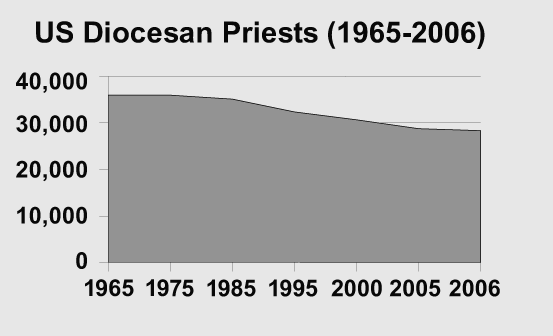 |
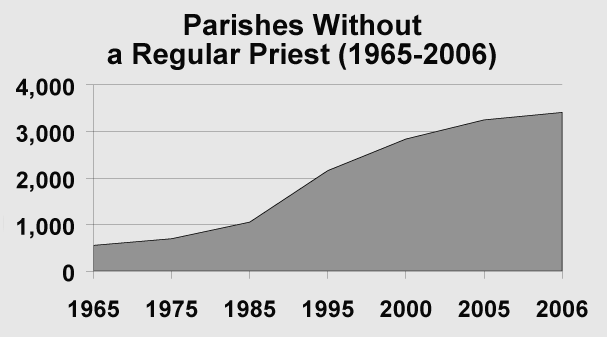 |
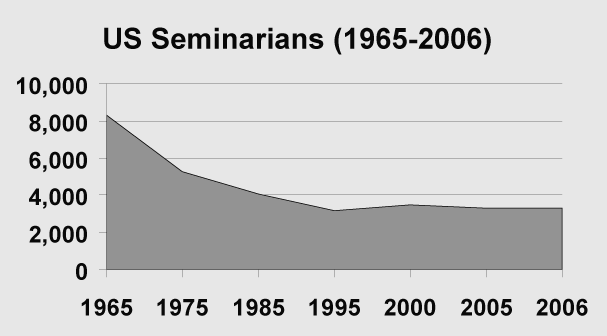 |
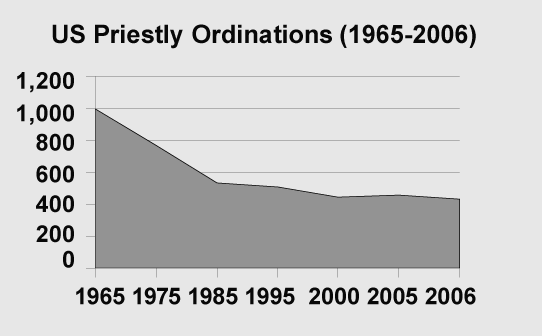 |
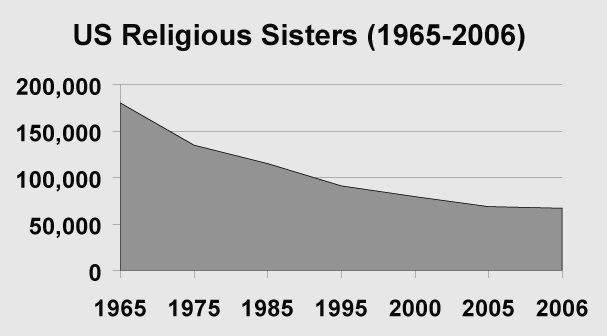 |
|
1) Is there a crisis in the Church today?
One would have to close one's eyes not to see that the Catholic Church is suffering a grave crisis. In the 1960's, at the time of the Second Vatican Council, there were hopes for a new springtime in the Church; exactly the opposite has come to pass. Thousands of priests have abandoned their office, and thousands of monks and religious have returned to secular life. There are very few vocations in Europe and not many in North America either; countless seminaries, convents, and religious houses have closed their doors. Many parishes lack priests, and religious congregations are obliged to abandon schools, hospitals, and homes for the aged. As Pope Paul VI lamented on June 29, 1972, "Through some crack, the smoke of Satan has entered the temple of God."1
Do we know how many priests abandoned the priesthood in the 1960's? According to an article by Fabrizio de Santis in the Corriere della Sera of September 25, 1971, somewhere between 7-8,000 priests had abandoned the priesthood in Italy alone over the previous eight years. In the Church as a whole 21,320 priests were reduced to lay status between 1962 -72. Not included in this number are those who didn't bother to seek official reduction to lay status.2 From 1967 to 1974, 30-40,000 priests abandoned their vocation. These catastrophic events can be compared with the effects of the so-called Protestant Reformation of the 16th century.
Has there been a comparable disaster in the congregations of nuns? Some comments by Cardinal Ratzinger illustrate what has happened by a single example. In the early 1960's, Quebec was the region that counted, proportionally speaking, the most nuns in the world. "Between 1961 and 1981, because of departures, deaths, and the end of new vocations, the number of nuns fell from 46,933 to 26,294, a decline of 44%, and there is still no end in sight. During the same period new vocations fell by at least 98.5%. A large part of the remaining 1.5% is composed not of young women but of late vocations. As a result, sociologists agree on a grim but objective conclusion: "Very soon...women's orders, as know them, will be nothing more than a memory in Canada."3
Is not the situation improving today, and can we not now consider that the crisis has past? In America in 1960, there were 1,527 men ordained to the priesthood. In 1998, only 460 were ordained–a decline of over 1,000 per year. In France in the 1950's there were about 1,000 priestly ordinations per year. In the 1990's there were no more than 100 per year; the number of entries into seminaries continues to decrease. In Germany, 1996 represented a new record low of candidates for the priesthood: German seminaries and religious ordes had only 232 entries; as recently as 1986 there were 727 entries.4 The number of religious in the world continues to decline.5
Does this crisis also affect the faithful? In the 1950's, Mass attendance in America was often higher than 70% among Catholics; some studies show that in 2000, this number had fallen to under 30%. In 1958, 35% of the French attended Mass every Sunday; today fewer than 5% do so, and these are often old people. In 1950 more than 90% of the French were baptized as children; today fewer than 60% are.
Is there not, however, an increase of adult baptisms in some countries? Several thousand adult baptisms cannot compensate for the loss of hundreds of thousands of infant baptisms (all the more since the perseverance of the late baptized often leaves something to be desired). Infant baptisms in America averaged over 1.3 million in the 1960's, yet has only recently come back over 1 million baptims a year, notably on account of the increase in the general population. Almost 150,000 adults converted to the Faith in America in 1960; in 2002, this number was under 80,000.
Is the case of France or America really typical? Everywhere interest in the Church is declining. Now only a minority of Catholics fulfill their Sunday obligations, and thousands leave the Church every year. It is especially disquieting that it is above all young people who turn their backs on the Church. Of the 93,000 who left the Church in Germany in 1989, 70% were under 35 years old. Between 1970 and 1993, 1.9 million Germans officially left the Catholic Church. Hatred or anger are not the most frequent causes, but simply indifference. The Church no longer speaks to people, she no longer has importance in their lives and thus people go their own way, sometimes simply to avoid the German church tax. Catholicism is on course to become the religion of a small minority. Germany is in danger, as Karl Rahner put it, of becoming a "pagan land with a Christian past and some vestiges of Christianity." The same holds true for most formerly Christian countries.
Can it not be said that this terrible crisis is merely local, affecting Western Europe and North America, but sparing Latin America, Africa, and Asia, where, on the contrary, Catholicism seems especially dynamic? Some statistics may suggest that the crisis is merely local. The Pontifical Annuary, for example, stresses that the increase in seminarians and ordinations in the Third World compensates for the decline observed in Western countries. In fact, the crisis is universal, even if it does not appear everywhere in the same way. (Poor countries, where the priesthood can represent social advancement, recruit new vocations relatively easily–but of what quality?) Latin America, for example, passes for a bastion of Catholicism, but it is in fact becoming Protestant at a more rapid pace than Germany did in the 16th century. In 1900, 3% of the population of Brazil were Protestants; they are now 16%, and the number continues to increase. Five new Pentecostal churches are built in Rio de Janeiro every week. Fr. Franc Rodé, secretary of the Pontifical Council for Dialogue with Non-believers, estimated in 1993 that the Church was losing 600,000 Latin American faithful every year. Other sources provide even graver indications: 8,000 Catholics a day pass over to sects.6 In Chile it is believed that 20% of the population has joined Protestant sects since 1960, and 30% in Guatemala. In the latter country, the number of Protestants increased sevenfold form 1960 to 1985.
2) Is this crisis a crisis of faith?
The Catholic Faith is dwindling away. Fundamental Christian truths such as belief in God, the divinity of Jesus Christ, heaven, purgatory, and hell are less and less believed in. Most disturbingly, these articles of faith are denied even by people who call themselves Catholic and regularly attend Mass.
Are there any statistics to illustrate this crisis of the faith? Without being altogether reliable, polls do represent general tendencies in society. Many statistics for the US can be found in Kenneth C. Jones's Index of Leading Catholic Indicators. For example, 77% of American Catholics in 1999 did not believe one must attend Mass on Sunday to be a good Catholic. Only 17% of young Catholics in America believe the priesthood should be restricted to males. Only 10% of Catholic elementary school religion teachers agree with the Church's teaching on artificial birth control. A 1992 poll in Der Spiegel showed that only 56% of Germans believe in the existence of God, 38% in his omnipotence, 30% in original sin, 29% that Jesus is the Son of God, and 24% in the existence of hell.7 Likewise catastrophic is the situation among Catholics. Only 43% of them believe in the fundamental dogma of the Resurrection of Christ. Of those who attend Mass on Sundays, only 55% believe in the Virgin Birth and only 44% recognize papal infallibility. Amongst all Catholics only 32% believe in papal infallibility. In France a recent poll8 showed that only 57% of the French consider the existence of God certain or probable (against 61% in 1994); 65% (and 80% of those 18-24 years old) say that they have no belief in the Trinity, and 67% (compared with 48% in 1994) do not believe in the existence of hell. Only 12% of Catholics say they definitely believe in hell (16% have some belief in hell, 72% deny its existence); even among regularly practising Catholics the statistics are catastrophic: only 23% of them firmly believe in hell, while 54% deny its existence. Thirty-four percent of these same practising Catholics are firmly convinced that Mohammed was a prophet, while only 28% deny it (35% believe it "up to a point," the others are not sure). Today, only 10% of French Catholics believe that Catholicism is the only true religion. "We can measure the depth of the change by noting that in 1952 most Catholics believed that there was but one true religion," observes the sociologist Yves Lambert.9 In Valais, the conservative canton of Switzerland that is home to the International SSPX seminary at Econe, 81.3% of Catholics maintain that all religions lead to eternal salvation.10
What lesson can we draw from these statistics? They show the true extent of the crisis. It is above all a crisis of faith. Not only is the number of those who consider themselves to belong to the Church diminishing, but even the majority of those who are officially members of the Church no longer hold the Catholic faith! Someone who denies a truth of the Faith has lost the Faith, for the Faith must be held as a whole. If 72% of Catholics reject belief in hell, not even one Catholic in three still has the Faith.
3) Is the crisis also a moral one?
A crisis of morality goes hand in hand with the crisis of faith. Whereas St. Paul reminded Christians that they should by their way of life shine in the eyes of a corrupt generation like the stars in the firmament (Phil. 2:15), the way of life of contemporary Christians differs little from that of the children of this world, unbelievers, and others. Their weak faith, emptied of substance, no longer has the strength to influence their life, even less to shape it.
What is the connection between faith and morality? Man as weakened by original sin always has the inclination to give his passions free course and thus to lose mastery over himself. The Christian Faith shows man what God expects of him and how he ought to conduct his life in accordance with the will of God. By the Faith man knows the promises of what he can hope for if he keeps the commandments of God, and also the punishments he will suffer if he turns away from God. The Faith and the sacraments give man the power to overcome his bad inclinations and to give himself entirely to the good and the love of God.
What are the moral consequences of a crisis of the Faith? When he loses the Faith man no longer believes that he is called to moral perfection and eternal life in God's presence. He will inevitably deliver himself more and more to the unregulated pleasures of this life.
Does the contemporary crisis of morality also affect Catholics? We are today experiencing this reality. Fidelity, purity, justice, the spirit of sacrifice are no longer uncontested goods, even for Christians. These days one marriage in three ends in divorce after five to ten years, and ever more Catholics seek Church recognition of separation and "remarriage" after divorce. Already in 1984 the review Herderkorrespondenz showed that, in the very Catholic region of Austria called the Tyrol, 88% of the population rejected the Catholic teaching on birth control, and that among the population aged 18-30 full adhesion to Catholic teaching in this regard was practically non-existent (1.8%). In the Valais 81.5% of Catholics believe that divorced and "remarried" Catholics should be able to receive Communion.11 In France in 2003 one quarter of practicing Catholics stated that, for them, the idea of sin had little importance. The number of annulments in America jumped from 338 in 1968 to over 50,000 in 1998.
4) Is there also a crisis of the clergy today?
The lack of vocations to the priesthood and the religious life together with the large numbers of priests and religious who abandon their duties show the profound crisis that is ravaging the clergy as well. Many of her members have lost the Faith, and the clergy in general is no longer capable of communicating and inflaming people with the Faith.
What is the connection between the crisis of the Faith and the crisis of the clergy? The crisis of the clergy is the cause of the crisis of faith amongst the faithful. If the faith of Catholics who attend Sunday Mass regularly is so weak, the cause must have its origins in defective preaching. If priests were regularly teaching the Catholic Faith the situation would be very different. Men have not lost the Faith on their own; it has been taken from them through catechism and from the pulpit. When over the course of years sermons put the truths of faith in question, relativize them, or even openly deny them, it is no wonder that simple believers lose the Faith. Often the young have never even known it.
Can you give an example of this bad teaching dispensed by the clergy? These days it is not unusual for a child making his First Holy Communion to be unaware that Jesus Christ is truly, really, and substantially present in the Eucharist. He doesn't know this because the parish priest himself no longer believes in this mystery. In How We Live, a book of religious instruction used in Germany, one reads that: "When Christians share their meal with Jesus, they go to the altar. The priest gives them a little piece of bread. They eat the bread."12 This book of religious instruction received an imprimatur and has been authorized by the German bishops!
Is the situation better in France? If 34% of regularly practicing Catholics believe "completely" that Mohammed is a prophet, and another 35% believe it to some degree (giving a total of 69%), we note that the statistic is much lower among non-practicing Catholics (21% and 22%, giving a total of 43%). On this question non-practicing Catholics are thus more Catholic than those who practice. This is evidence of the kind of teaching being dispensed at church. In fact, many French bishops have given churches to the Muslims, and Pope John Paul II kissed the Koran on May 14, 1999.14
Is the crisis of the clergy also a moral crisis? The crisis is above all a crisis of faith, but a clergy of such weak faith cannot have the strength to observe celibacy, for this is possible only for someone animated by living faith and great love for our Lord. It surprises no one that many priests today maintain sinful relationships with a woman, and do so more and more publicly. It is common to hear that a priest has abandoned his post, admitting that he had not been celibate for years prior. And, in this regard, the situation of the clergy in the Third World (whose numbers are increasing) is unfortunately no better.
Are not these departures of priests deliberately brought to public attention in order to win the suppression of priestly celibacy? It is clear that celibacy keeps many young people away from the priesthood. But rather than entering into polemics on this question, it would be better to ask why there used to be so many men who gladly made this sacrifice, and why this is is no longer the case today.
5) How does the current crisis differ from Church crises in the past?
The current crisis in the Church is distinct from those of the past above all in the fact that it is the highest authorities in the Church themselves who have unleashed this crisis, who maintain it, and who prevent the implementation of effective measures for its resolution.
Have there not been very grave crises in the Church in the past? There have always been crises in the Church. Priests, bishops, and even popes have not always lived their lives in accordance with the Gospel. Immorality and indiscipline among the clergy have often led to decline in the Church. From time to time priests and bishops have departed from the true Faith. But never, as in our times, have errors and the public negation of truths of the Faith been spread abroad thanks to the tolerance, approbation, and even the active efforts of the Roman authorities and the episcopate throughout the world. This is the peculiar characteristic of the current crisis: the fact that it is favored by the highest authorities in the Church, including the pope.
Has this singular character of the current crisis been recognized by the authorities in the Church? Pope Paul VI himself in 1968 made his famous declaration that the Church finds herself in a state of "self-destruction":
The Church today finds herself in a state of disquiet, self-criticism, one might even say of self-destruction. It is like an interior upheaval, acute and complex, which no one expected after the Council....as though the Church were striking herself.15
1 Der Fels, No.10, 1972, p.313; La Documentation Catholique, No. 1613, 1972, p. 658.
2 May, Georg, Die Krise der nachkonziliaren Kirche und wir (Vienna: Mediatrix Verlag), pp. 50ff.
3 Joseph Cardinal Ratzinger, Zur Lage des Glaubens (Munich, Zurich, Vienna: Neue Stadt, 1985), p.102. Cardinal Ratzinger and Vittorio Messori, Entretien sur la foi (Paris: Fayard, 1985), pp. 117-18.
4 Osterhofener Zeitung, April 19, 1996.
5 Deutsche Tagespost, August 13, 1998.
6 Présent, May 22, 1993.
7 Der Spiegel, 25/1992. pp. 36ff.
8 CSA poll, La Vie–Le Monde, taken in March, 2003.
9 Report of INSEE, Données sociales: La société française (2002-2003 ed.), study by Yves Lambert (CNRS) on "La religion en France des années soixantes a nos jours (Religion in France from the 1960's to Our Day). The author notes that the great rupture goes back to the mid-1960's, marked by a decline in religious practice and belief. Formal adherence to religious confessions persisted somewhat longer, showing its first notable decline in 1975-76.
10 Poll taken by the Link Institute, September 1990.
11 Link Institute, 1990.
12 Wie Wir Menschen Leben: Ein Religionsbuch (Herder, 1972), p. 78. The imprimatur was given on January 17, 1972, by the General Vicar of the Diocese of Freiburg, Dr. Schlund.
13 Ernst Kirchgassner, Jesus: Diener der Menschen, Volume 51 in the series Reihe für Dich (Ulm: Süddeutsche Verlaggesellschaft), pp.27ff.
14 See Le Sel de la Terre, No.31, p.186.
15 Speech on December 7, 1968; La Documentation Catholique, No. 1531, 1969, p.12.
